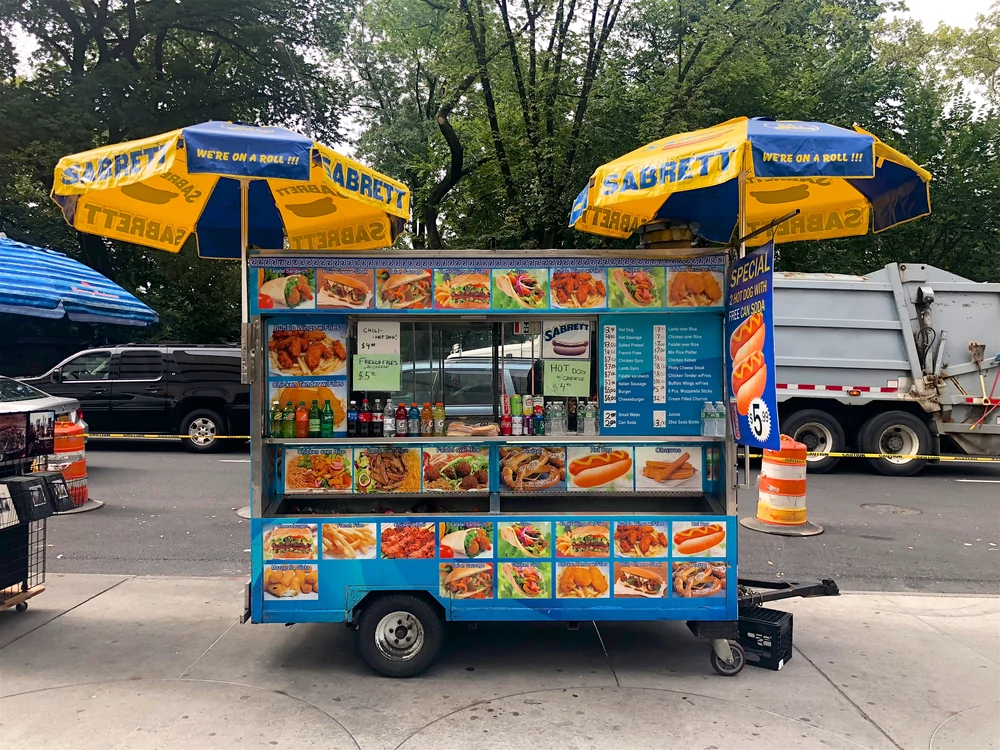A hot dog cart might be as much a part of New York City as the Statue of Liberty and the Empire State Building, but what does it cost to run a portable eatery in one of the most expensive cities in the world?
Like everything else in New York City, it comes down to real estate. The cost of operating something as small as a hot dog cart all depends on where the operation is in the city, but vendors also have to contend with the New York City permitting process or the New York City Department of Parks and Recreation’s bidding process.
A mobile food vendor in New York City has to have a food vendor license and a mobile food vendor permit to operate anywhere in the city, but, by law, the city is only able to issue only 2,800 full-term citywide permits for mobile food vendors. These permits are valid for two years and cost $200. In addition to these permits, however, there are 100 permits exclusively for veterans and disabled people, 200 borough-specific permits, with up to 50 of these that are available for each borough except Manhattan, 1,000 seasonal permits for use between April and October, and 1,000 green cart permits, which are those carts that only sell fruits and vegetables.
There is a waiting list for every available permit, and this has led to a problem. Vendors can renew every two years, but some have bought up blocks of the capped permits for street carts. They then lease the permits that cost $200 out to other vendors at an exorbitant rate, creating a black market for permits. Some vendors pay upwards of $10,000 to $20,000 (and possibly more) to lease these permits.
Vendors pay the high leases to those who have the permits because the waiting list is so long. Some operate illegal food carts without a permit and take their chances of getting fined by doing so. This led to the city council enacting a law in 2022 that would provide an additional 445 mobile food vending permits per year for the next ten years.
The New York City Parks Department has its own permitting, and in order for a food vendor to get a prime spot in or near one of the city’s parks, they have to bid on it. Vendors make a competitive sealed bid where only the highest fee offered gets that spot. These spots are bid on every five years, with the highest bid receiving the permit to operate. These costs have increased dramatically over the last ten years, and the city makes more than $4.5 million a year on just these concession permits.
According to The New York Times, the areas around Central Park are the most expensive to get, with the spot near the Central Park Zoo being the priciest. In 2013, that prime spot cost $289,500 a year to run a hot dog or another food cart. That was just the fee paid to the city and doesn’t include any other expenses incurred from running the cart. These increase each year. But the bids have increased dramatically, with spots around the city parks having much higher bid amounts.
According to the city’s 2022 bid results, the cheapest bid was $700 for a spot in the Bronx, which went to $920 in year five. Most of the bids in the boroughs, except for Manhattan and Central Park, went for between $1,000 and $10,000 for the first year of operation. Spots in Central Park were a different story. Winning bids here started at around $70,000 and went to around $150,000, with the highest being a winning bid of $175,000 for year one. This vendor would be paying $184,000 in year five.
The largest winning bids were in Manhattan in spots governed by the parks department that were not in Central Park. These bids ranged from one at $1,000 up to sites in the $200,000 range. The highest winning bid came in at $350,000 in the first year for a mobile food spot, with the cost at year five being a mind-boggling $500,000. That’s a tremendous amount of hot dogs and other food items to have to sell to make a profit.
But with these high fees come a few problems. Some pushcart vendors can’t afford to pay and bid way over their heads for a prime spot. They simply can’t make enough money to pay the monthly rent by selling enough hot dogs or other food. Some vendors have been caught inflating prices on their carts to unaware tourists, which is against the law. Prices and menu items are approved by the New York City Parks Department, setting what a pushcart vendor can charge. Price inflation is something the city has had to continually crack down on.
The high rates to operate these carts don’t seem to be a deterrent to vendors since there is always a perpetual waiting list and high bid amounts, but a more important question remains. Where do all those pushcarts go at night?
They are either loaded on flatbed trucks, which can hold a few carts at a time, or they’re loaded in vans. Some have motors that allow them to be moved, while others are simply moved by hand. Most of the time, they are stored in garages in Western Manhattan, where they can be restocked and readied for the next day. But this adds yet another fee for these food vendors since they must rent out the spot just to store their carts. All this requires selling a lot more hot dogs and other food items to keep their businesses running.
Sources: nyc.gov (1), nyc.gov (2), NYC Parks (1), NYC Parks (2), NYC Parks (3), NYC Parks (4), The New York Times (1), The New York Times (2), New York Post, New York Magazine



